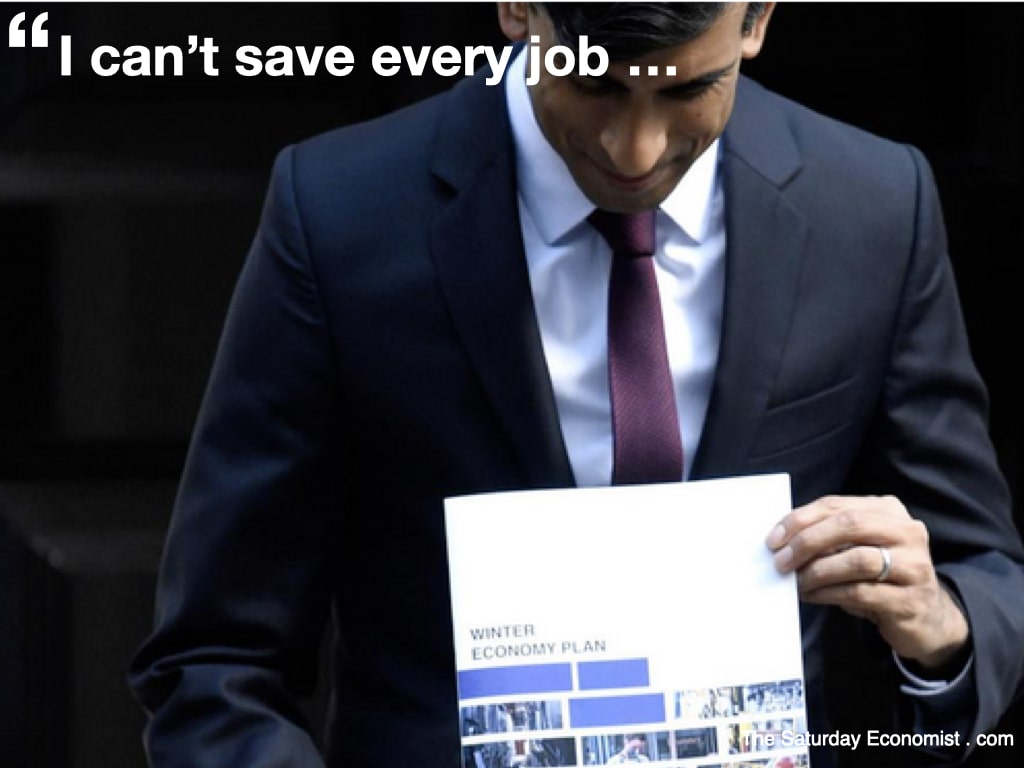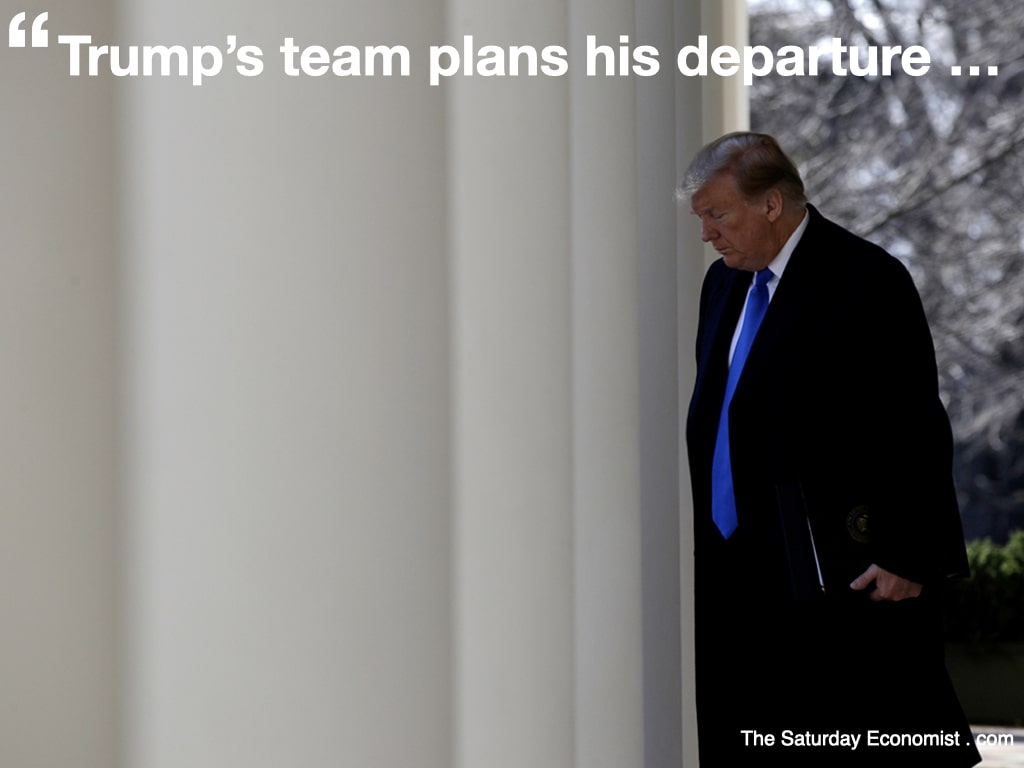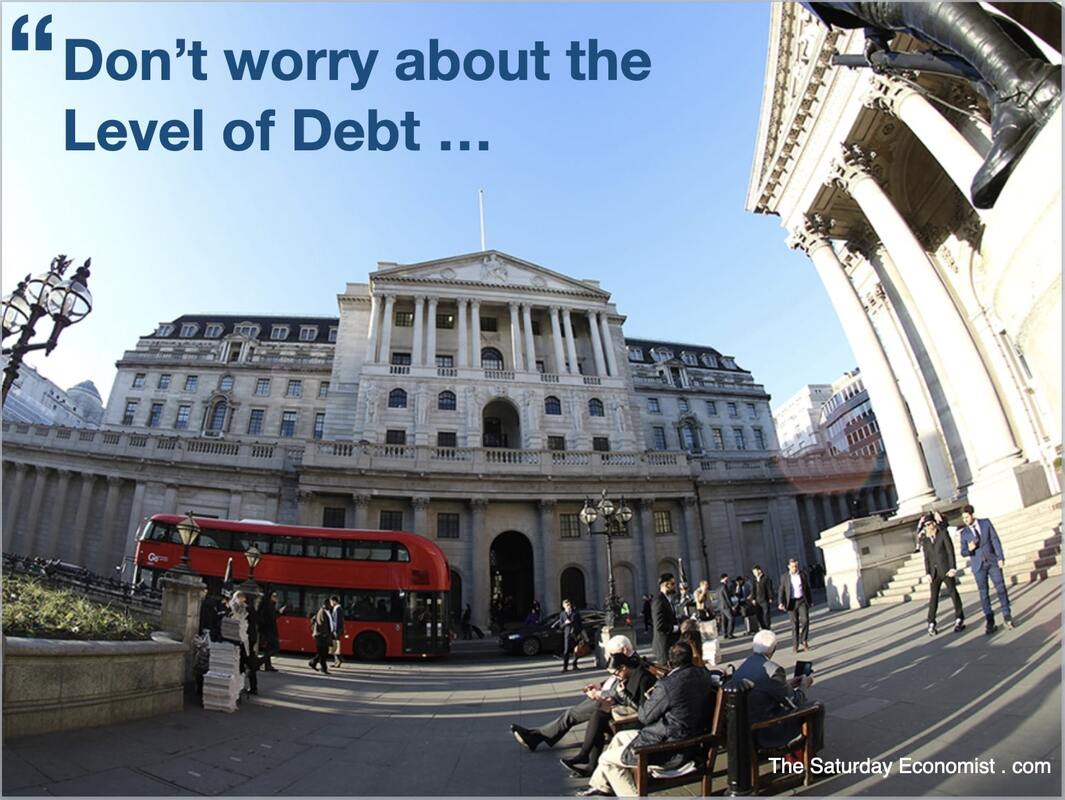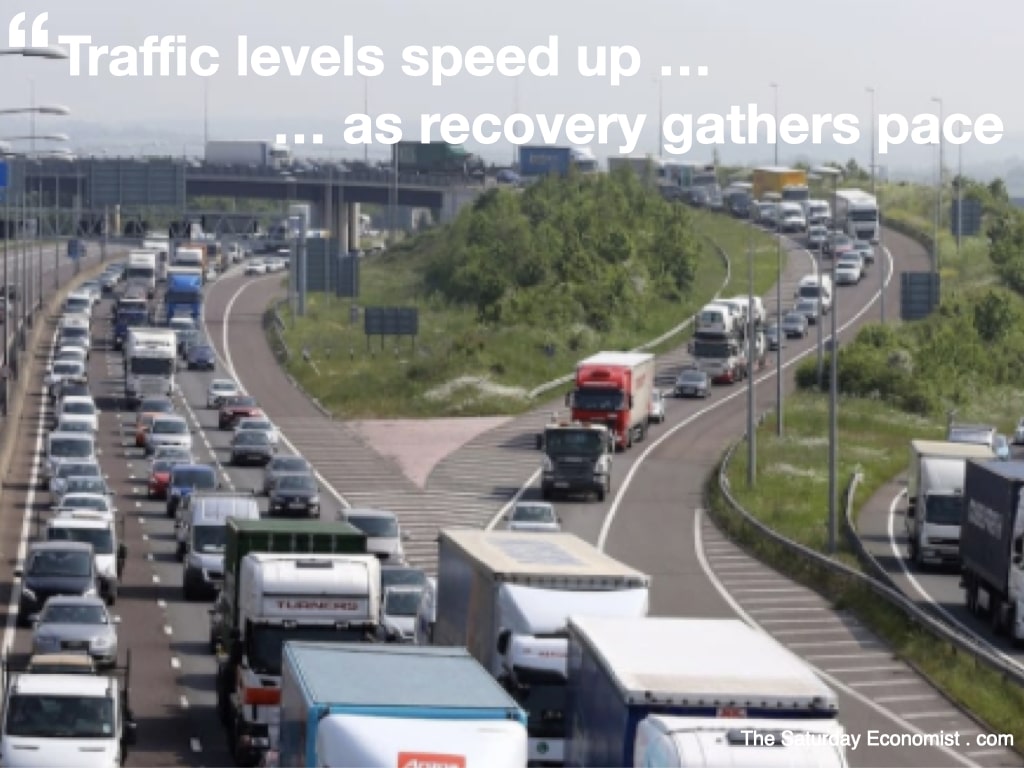|
It was always going to be a difficult week. The Monday warm up act was Sir Patrick Vallance and Chris Whitty. The Chief Medical advisers, were there to set the tone.
The rate of Covid infections is increasing. "If the current level of infection doubles every seven days, there will be 50,000 cases every day by mid October." Continuance at the same rate would mean over one million infections per day by mid November. By Christmas, the whole population of the UK would have been infected. President Trump's concept of "Herd Mentality" achieved. It was left to Ed Conway on Sky News to point out the current rate extrapolation would mean just 13,000 cases by the October hurdle date, not the 50,000 as claimed. Detail did not really matter. The stage was set for the Prime Minister to deliver the news of further lock down measures across the U.K. Pubs and restaurants must close by 10.00 pm. Staff would be discouraged from returning to the office. Business conferences, exhibitions and large sporting events, would not be reopening as planned. Face masks must be worn. No more than fifteen can attend a wedding, thirty may continue to attend a funeral. The measures were to last for six months. No reprieve for Christmas. London placed on a high risk list. Mayor Sadiq Khan warned, further lock down measures could be imposed in the capital. The measures were a further blow to the hospitality and leisure sector and to an events business already on the floor. The hand over team were readying the stage for the Chancellor to ride to the rescue. The planned budget was scrapped. Rushi Sunak announced his "Winter Economic Plan". Would the furlough scheme be extended as hoped? At a projected cost of £52 billion by the end of October, so what of a further £20 billion into Easter next year. Official figures on Friday would reveal borrowing for the year to date had already reached £175 billion. The OBR forecast of £320 billion for the financial year well in reach. The Chancellor's Winter plan revealed further extension of the VAT cut for the hospitality sector. Generous cash flow provisions were added for VAT and Loan repayments. The furlough scheme would come to an end as planned. The complex Job Support Scheme would be introduced. At best the jobs crisis may be postponed to the end of January. "I cannot save every business, I cannot save every job" warned the Chancellor. Sector specialists warned of one million jobs lost in the hospitality sector and 300,000 in the events business. This week, Lord Wolfson, head of Next, warned of hundreds of thousands of job losses in the retail sector, as the online shift continued. The unemployment rate is set to rise to over 8% by the end of the year. The number of people out of work could rise to three million by Christmas. In reality our forecasts for the current year have not changed much. Our hopes remain, for a positive bounce back next year ...
0 Comments
The President was asked at a press conference this week if he would commit to a peaceful transfer of power after the election. Trump declined to answer, in the affirmative.
No surprise really. This would be an admission of defeat. Instead the President managed a non committal response and a complaint about the election process. "Well, we're going to have to see what happens," he said. "You know that I've been complaining very strongly about the ballots, and the ballots are a disaster," "Get rid of the ballots and you'll have a very peaceful transfer, there won't be a transfer, frankly. There will be a continuation. The ballots are out of control." Without the ballots there would be four more years for Trump. President Trump refuses to commit to a peaceful transfer of power if he loses. But his team is developing plans for that very outcome. According to Politico, one of the most organized and functional parts of the Trump White House, is the West Wing office, planning the potential presidential transition As the president rails against mail-in ballots and “Sleepy Joe Biden,” assistant to the president Chris Liddell has spent weeks mapping out a possible handover of power. Senior Republicans offered reassurance ... “The winner of the November 3rd election will be inaugurated on January 20th,” wrote Senator Majority leader Mitch McConnell. “There will be an orderly transition, just as there has been every four years since 1792.” Are the Republicans already preparing for defeat? The race to appoint a conservative to the supreme court, ahead of the election is evidence of concern. The move has angered many Democrats who believe a Supreme Court judge should not be nominated until after November election. In 2016, Republicans didn't let President Obama fill the opening with his pick. This year, Senate Republicans are readying for confirmation hearings in two weeks, with a vote in the full chamber expected before Election Day. So what's the rush ... if you are so sure you have a winner in the White House? Retail sales increased by almost 3% in August. Excluding fuel, total sales volumes increased by over 4%. DIY led the charge. B&Q and others benefited, with DIY sales up by 20%. Garden centres were blooming. Green fingers tapped the tills with a 17% increase in horticultural goods year on year
The public was drinking less apparently. Alcohol sales were down by 6% compared. Alternative medicine provided some relief. Chemist sales were up by 44% and medical goods were up by 17%. The upturn in the housing market, boosted sales of white goods and floor coverings. Pride in appearance appeared to take a back seat. Sales of clothing, cosmetics and footwear were down over 15%. Watches and jewellery sales were down by 12% in the month. The surge in online sales continued. The year on year growth was over 50% accounting for 28% of all retail transactions. Online food sales were up by 90% year on year, accounting for 10% of all food action. The pressure on retail continues. John Lewis announced the closure of four more Waitrose stores this week. In July the company revealed, that eight John Lewis stores would close, including the flagship Birmingham store. Online sales increased by 73% within the group. Radical restructuring will continue within the retail sector. Book sales were up by 18%. Analysts must have been rushing for the textbooks as the Bank of England suggested it was reviewing once again the possibility of negative interest rates. The MPC decided to maintain the level of interest rates at 0.1% for the moment. Inflation CPI basis slipped to 0.2% in August. The Eat Out to Help Out scheme explained some of the price discount. A stronger Sterling and a weaker oil price undoubtedly helped. Music sales slipped by 8% as streaming services continued to increase share. A neat segue to point out you can now get The Saturday Economist as a Podcast, available on Apple, Google, Amazon, Spotify and more. Check out the details below ... Unemployment increased in the three months to July by 60,000, to a level of 1.4 million. The u rate moved higher to 4.1% compared to 3.9%. Despite the increase, the employment rate was actually higher. 33.0 million were in work, compared to 32.8 million over the same period last year.
Vacancies in the economy continued to rally from the June floor. The number of vacancies increased to 434,000 up from 341,000 in June, still well off the high of 820,000 in February this year. Job levels within the economy continue to be supported by the Government furlough scheme. The number of people estimated to be away from work, temporarily, was around 5 million in July. Some evidence suggests this number may have fallen to around 3 million at the end of last month. The overall picture is confusing, with fears of a radical job loss by the end of the year of great concern. The claimant count increased to 2.7 million by the end of August, an increase of 1.5 million since March. Redundancies are on the increase. Early indicators suggest the number of employees on UK payrolls was down by 695,000 compared to March according to the ONS. The number of unemployed may have already increased to 2 million. The u rate may have risen to almost 6%. The Chancellor of the Exchequer is under pressure to extend the furlough scheme. The Treasury is reluctant to continue support in the current form. Rishi Sunak told the BBC this week, looking for new ways to protect jobs is his "number one priority". Finding innovative solutions was top of mind. Let's hope shutting down the economy for a two week "fire break" doesn't feature in the plans. The Prime Minister announced this week, the second wave is coming. Yes Labour and Tories are neck and neck in the polls ... That's all for this week! Have a great, safe, week-end ... The ONS released the preliminary monthly estimate of GDP for the month of July. The economy continues to recover from the shock of shutdown. Businesses are returning to some semblance of normality.
Compared to prior year, output fell by just over 20% in the second quarter. We now expect output to fall by just over 10% in the third quarter and by around 5% in the final quarter of the year. (All figures in comparison with prior year). For the year as a whole, this means output will have fallen by 10% in 2020 compared to prior year. The stage is set for a significant bounce back in 2021. If nothing else, the year on year comparisons will be so easy to beat. We now expect manufacturing output to be down by 10% in Q3. This is a 2% improvement on our earlier estimate. Construction output will also be better than expected, down by 15% in Q3 compared to our more pessimistic 20% prognosis. Bear in mind construction output slumped by 35% as the clampdown was imposed. Retail and distribution output is expected to return to prior year levels in the second half of the year. The volume of activity is returning to normal. The shift on line continues to create problems for retail footprints and jobs on the shop floor, as we explain below. The most vulnerable sectors to shut down, are identified in arts and entertainment, down by 35% in the third quarter. Hotels and restaurants remain the most blighted sector. Output in Q3 we now expect to be down by 60% in the third quarter and by 25% by the end of the year. The detailed numbers of our sector model, have been included in the data set below. So what does this mean for jobs? In the worst case scenario, over 3 million could be out of work by the end of the year. This week, Andy Haldane, Chief Economist at the Bank of England warned the government against an extension of the furlough scheme. "A necessary process of adjustment" is taking place. An extension would delay the "inevitable" shake-out of businesses hit by the pandemic, the Chief Economist explained. Is this really the case? it is important to distinguish between structural unemployment and cyclical unemployment. The Haldane hard line is probably correct for those jobs subject to structural shift. For those sectors which are more cyclical, further support into Easter next year would be a more appropriate response. The government will have a heavy price to pay, either way ... Retail sales are rising but restructuring is taking place. More sales are now online in food and non food sectors. The number of stores required for "national footprint" is shrinking. Portfolio stores with marginal or negative profitability are no longer justified by high street presence and national marketing rationale. Rising rents and business rates merely exacerbate the pressure on profits from lower sales per unit.
The proportion of food sales on line has doubled to over 10% over the past year. It is expected to double again within three years. 29% of all retail sales were online according to the latest data for July. Almost one in three transactions in non food have been lost to the high street and shopping centers. The success of Asos, Boohoo and Misguided attests to the expansion of clothing sales on line. AO is becoming the dominant player in white goods sales. Online marketing and logistics are the Key Success Factors. As The Hut Group heads for a listing, it was interesting to see the deal signed with Homebase. The ten year deal will provide a "digital transformation partnership" for the home and garden retailer. The multi million pound deal will fast forward the plans for web development, hosting, logistics, payment and delivery. This week, the Centre for Retail Research estimated the number of retail jobs lost in the UK in the year to date had risen to 125,000. Almost 15,000 stores have closed permanently. Approximately 95,000 jobs were lost over the same period last year. Debenhams, Monsoon, Oasis, Warehouse, Cath Kidson have fallen into administration as the perfect storm continues. Fallen retailers are vulnerable to the asset strip in which brand, stock and online presence are retained. Stores and staff are abandoned in a quick fix CVA. Batching a number of brands under the same logistics umbrella provides further economies of scale. Recent figures indicate the number of empty shops on the high street has risen to the highest level in six years. London footfall has suffered as tourists stay away and office staff levels remain well below normal. The British Retail Consortium has warned of more pain in September as high street sales remain below pre-pandemic levels. The Chancellor will have to make a difficult decision to determine if the retail sector is a suitable case for treatment, if the furlough scheme is to be extended. The decision on job retention and store closure may well be out of his hands anyway ... Don’t worry about the level of national debt, like old soldiers, much of the debt will just fade away … the Bank of England holdings may never be repaid ... according to the latest update from The Saturday Economist ...
According to the latest borrowing figures, the national debt in the UK has exceeded the level of GDP for the first time since 1961. The National Debt has risen to just over £2 trillion pounds. It is the first time the debt to GDP ratio has been so high since 1961. Should we be worried about the level of debt? The Bank of England has pointed out the debt to GDP ratio has exceeded unity, in over 100 of the last 300 years. Thrift, it would appear, is a post war phenomenon. The cost of borrowing means the cost of funding the deficit remains extremely low. The Bank of England has reduced the base rate to just 0.1%. The cost of ten year gilts has fallen to just 0.3%. No worries about a gilt strike. The pretence of QE abandoned. The Old Lady of Threadneedle Street is on standby as the buyer of last resort. Almost £1 trillion of gilts could end up in the bank’s coffers, if the spending spree continues. The OBR are projecting debt to rise to £2.2 trillion this year. The Bank have committed to £745 billion or 34% of total issuance The OBR projection is for debt to rise to £2.6 trillion by 2023/2024. The Bank share would fall to 29%. It would take just another £100 billion to maintain the plug at current levels! The £1 trillion Bank note, would not be that much of a step to make. The £1 trillion Bank note is coming … So should we worry about debt repayment? Government borrowing is financed by the issue of “gilts” from the Debt Management Office. Much of the debt issued is acquired by UK and overseas institutions. According to the latest published data from the DMO (Q1 2020)*, 30% of debt issued was owed overseas. 32% was in the hands of UK insurance companies and pension funds. A further 13% was held by UK financial institutions. The Bank of England holdings were approximately 25% of total debt at the end of the first quarter, valued at just over £500 billion pounds. According to latest commitments from the MPC, the total amount is set to rise to £745 billion by the end of the year,. The level may rise to £1 trillion if the spending spree continues. The gifts purchased by the Bank of England from the Debt Management Office are underwritten by Treasury. Coupons paid by the DMO to the Bank are remitted to HM Treasury, it is their debt after all. We call this “Dire Straits Economics … Money for Nothing Gilts for free.” The Debt Management Office is also a wholly owned by the UK government. The parent organization is HM Treasury. It is an executive agency of HM Treasury responsible for debt and cash management for the UK Government. The Bank of England is wholly owned by the UK Government. The capital of the Bank is held by the Treasury Solicitor on behalf of HM Treasury. The gilt assets held by The Bank of England are a liability owned by the Treasury. Both the Bank of England and the Treasury are subsidiaries of government. No need for formal repayment. The debt will simply fade away at some suitable stage in the future. Rollover dates will lapse. The two sides of the balance sheet will be reconciled. No need to worry about paying back the debt, over 30% of the national debt, almost £ 1 trillion pounds, will just fade away ... About The Author ... John Ashcroft PhD BSc.(Econ) FRSA is a specialist in economics, strategy and financial markets. He is the author of The Saturday Economist and The Saturday Economist Live. Educated at the London School of Economics, London Business School and with a PhD in economics, John is based in Manchester, UK. Workers may yet be slow to return to the office but traffic levels are speeding up, according to the Department of Transport. Road traffic is gradually returning normal. Schools are re-opening. The volume of car traffic is returning to levels pre lock down. Light commercial vehicle traffic is already back to the levels of early March.
So is the recovery speeding up? The latest survey data from IHS Markit, suggests manufacturing production is rising at the fastest pace since May 2014. The overall volume index increased to 55.2 from 53.3 prior month. Output and new orders increase at "accelerated" rates as businesses re-opened. The service sector reported a further rise in activity in August. The headline index increased to 58.8 in the month, up from 56.5 in July. This was almost double the levels of activity reported in the second quarter. A quarter in which the drop in GDP(O) for the sector was 20%. Providers reported the sharpest increase in new work since December 2016. Pent up demand in the housing market and the success of the "Eat Out To Help Out" scheme boosted the growth in activity. Output in the construction sector continued in positive trend. The headline index registered 54.6, albeit down from the heady 58.1 recorded in July. House building remained the best performing category (60.7) with a slower performance recorded in commercial work (52.5) and civil engineering (46.6). Companies reported an improvement in business expectations for the year ahead, largely on the back of major infrastructure projects and public sector construction spending. So what's the problem? At this stage in the recovery, businesses remain uncertain about the strength of the recovery and the probable increase in job losses. Duncan Brock, Group Director CIPS explained ... "the manufacturing sector may be experiencing a 'V" shaped recovery. However, amidst the positivity, the elephant in the room remains the poor employment numbers." This week job losses and store closures were announced by Pret and Costa. Job gains were revealed by Amazon and Tesco. Further pressure will be placed on the Chancellor, to extend the furlough scheme into the New Year, especially for those sectors slow to recover as we have long explained. Then of course, there remains, the delicate issue of Brexit ... Duncan Brock continued " Companies are looking at how to stay in business for the rest of the year as challenges from the pandemic retreat a little only to be replaced by Brexit" ... ah yes Brexit, it's now over four years since the referendum ... Just when you thought there was a chance of a deal, Boris Johnson has demanded that British fishermen should double the catch from coastal waters. EU negotiators claim that one in three European fishing boats would be lost at sea, if the UK haul increases. They have rejected the British proposal out of hand.
What's the fuss about fishing? Fishing is worth about £500 million to the UK economy. That's less than the annual turnover of Harrods, according to the Times and less than half a day's borrowing for the government according to simple mathematics. Fishing has a symbolic resonance in the UK and in Europe, particularly France and Spain. French fishermen are effective lobbyists and Macron faces an election in 2022. For the Prime Minister, the Leave campaign was supported by fishing groups. Fishing became a symbol of taking back control. It remains a significant stumbling block to a deal. Additional problems remain about the "level playing field" and the issue of state aid. The Prime Minister is keen to ensure the UK government will have the ability to intervene in industrial strategy. On what terms, no one in the Conservative Part can be quite sure. "Picking winners", "supporting losers" "investing in tech" the agenda is a little unclear. History records the UK Government track record on such matters has been hazardous at best. Brussels requires assurances, that Britain will not use subsidies to undercut EU companies. To date, the government has failed to explain, to the EU and to Parliament, just what the plans and platform would be for state intervention and engagement. Time is running out. Michel Barnier, the EU's lead negotiator, has warned a deal must be agreed by the end of October, if it is to be ratified in Brussels by the end of the year. In no deal is agreed, the UK and the EU will trade on WTO terms. Recent rounds of negotiations have failed to lead to a breakthrough. Ian Duncan Smith said, "The EU has shown bad faith" adding "The EU has to be prepared to bend. If they don't bend, they don't get a deal" ... David Davis called on Boris Johnson to repudiate the Withdrawal agreement. No trade deal, no divorce settlement and no divorce bill. "We can repudiate it and see them in court" ... socially distanced of course ... |
The Saturday EconomistAuthorJohn Ashcroft publishes the Saturday Economist. Join the mailing list for updates on the UK and World Economy. Archives
July 2024
Categories
All
|
| The Saturday Economist |
The material is based upon information which we consider to be reliable but we do not represent that it is accurate or complete and it should not be relied upon as such. We accept no liability for errors, or omissions of opinion or fact. In particular, no reliance should be placed on the comments on trends in financial markets. The presentation should not be construed as the giving of investment advice.
|
The Saturday Economist, weekly updates on the UK economy.
Sign Up Now! Stay Up To Date! | Privacy Policy | Terms and Conditions | |









 RSS Feed
RSS Feed